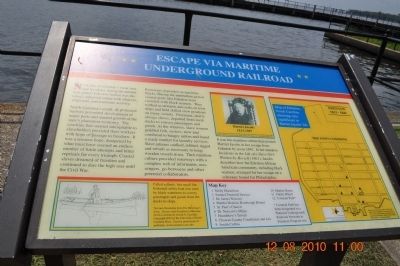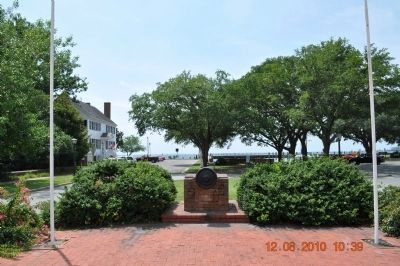Edenton in Chowan County, North Carolina — The American South (South Atlantic)
Escape Via Maritime Underground Railroad
North Carolina's small, ill-protected harbors prevented development of major ports and stunted growth of the state's plantation economy. The coastline that seemed inhospitable to slaveholders provided their workers with hope of passage to freedom. It was a tenuous hope, dampened by what must have seemed an endless number of futile attempts and bitter reprisals for every triumph. Coastal slaves dreamed of freedom and continued to dare the high sea until the Civil War.
Runaways depended on maritime blacks. During the antebellum period coastal ports like Edenton were crowded with black seamen. They worked as stewards and cooks on most ships and held skilled crew positions on many vessels. Ferrymen, nearly always slaves, departed from local docks to covey passengers and goods. At the wharves, slave women peddled fish, oysters, stew and cornbread to hungry sailors and found a ready marked for laundry services. Slave artisans caulked, refitted, rigged and rebuilt as necessary to keep wooden vessels at sea. Their maritime culture provided runaways with a complex web of informants, messengers, go-betweens and other potential collaborators.
It was this maritime culture that assisted Harriet Jacobs in her escape from Edenton by sea in 1842. In her narrative Incidents in the Life of a Slave Girl: Written by Herself(1861), Jacobs describes how the Edenton African American community, including black seamen, arranged for her escape on a schooner bound for Philadelphia.
(Sidebar):
Called a flattie, this small flat-bottomed utility boat was used by black watermen to convey passengers and goods from docks to ships.
Text and illustration from The Waterman's Song: Slavery and Freedom in Maritime North Carolina by David S. Cecelski. Copyright 2001 by the University of North Carolina Press.
Topics. This historical marker is listed in these topic lists: Abolition & Underground RR • African Americans • War, US Civil. A significant historical year for this entry is 1842.
Location. 36° 3.369′ N, 76° 36.598′ W. Marker is in Edenton, North Carolina, in Chowan County. Marker is at the intersection of South Broad Street and East Water Street on South Broad Street. At the end of Broad St. along the waterfront near the Barker House. Touch for map. Marker is at or near this postal address: 505 South Broad Street, Edenton NC 27932, United States of America. Touch for directions.
Other nearby markers. At least 8 other markers are within walking distance of this marker. Silent Service Memorial (a few steps from this marker); Penelope Barker (within shouting distance of this marker); Penelope Barker House (within shouting distance of this marker); Edenton (within shouting distance of this marker); Edenton Bell Battery C.S.A. (within shouting distance of this marker); Sea Port Fame Brings Famous Forefathers — Nation's Leaders, to Edenton (within shouting distance of this marker); Our Confederate Dead (within shouting distance of this marker); 1886 Roanoke River Lighthouse (within shouting distance of this marker). Touch for a list and map of all markers in Edenton.
Credits. This page was last revised on June 16, 2016. It was originally submitted on August 23, 2010, by Sandra Hughes Tidwell of Killen, Alabama, USA. This page has been viewed 2,823 times since then and 136 times this year. Photos: 1, 2. submitted on August 23, 2010, by Sandra Hughes Tidwell of Killen, Alabama, USA. • Craig Swain was the editor who published this page.

